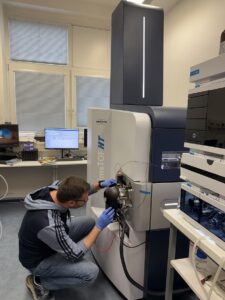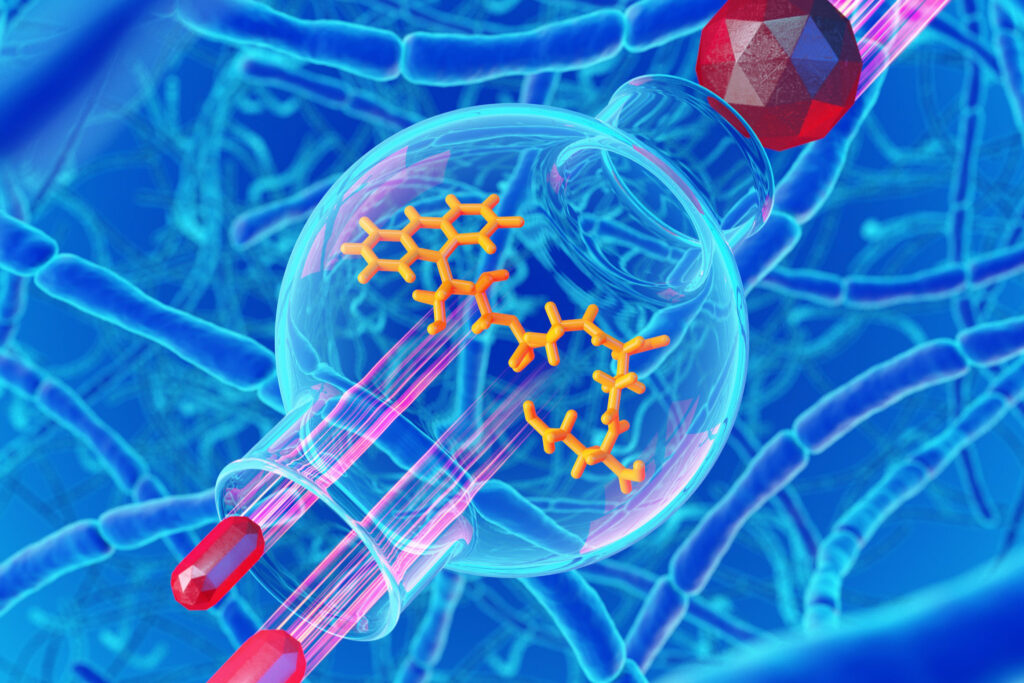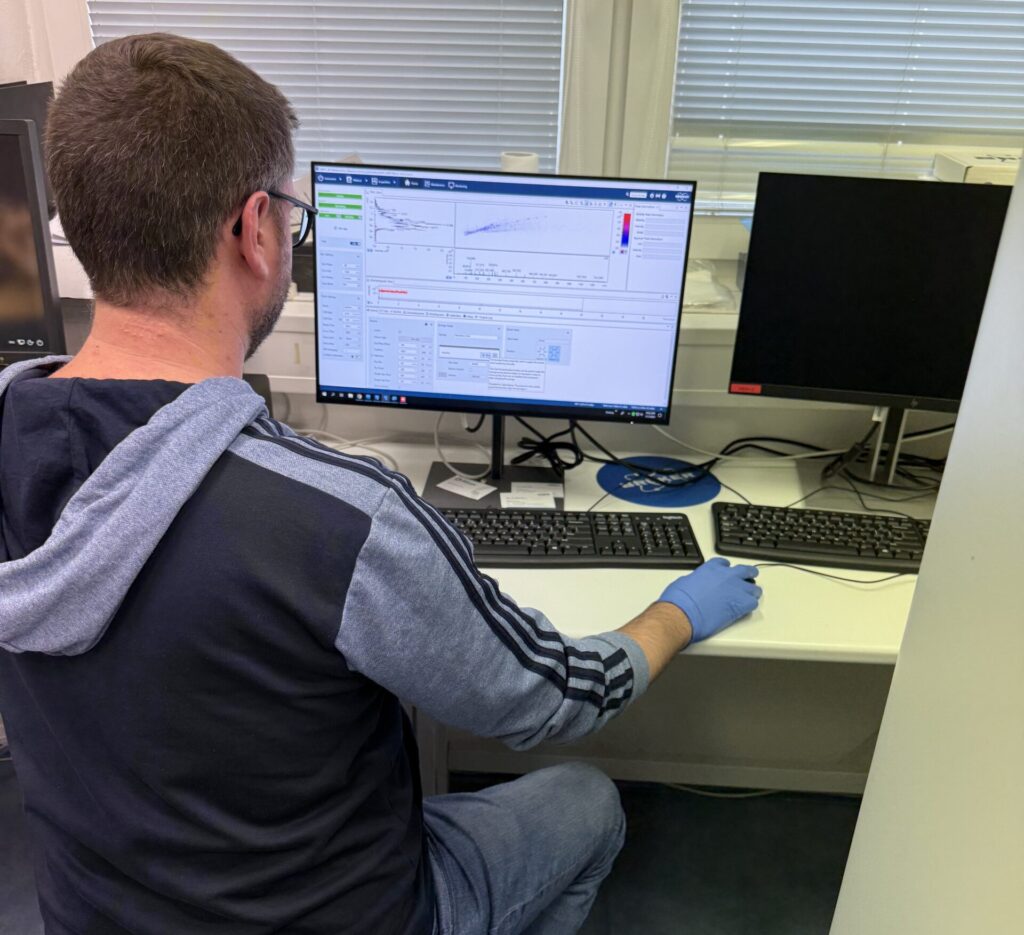Metabolomics
Metabolomics is a relatively new scientific field, which complements other OMICs strategies: genomics gives us an (ideally) complete information of all genes within an organism (its genome), transcriptomics tells us whether the genes are active (transcribed into mRNA), and proteomics describes all proteins in the cells. Metabolomics, on the other hand, provides a close-to-complete picture of small molecules, metabolites, in a cell or more generally, in a sample. By contrast to chemically uniform DNA, RNA, and proteins, metabolites are characteristic with very diverse structures of various physico-chemical properties. This adds complexity to metabolomics, but we’ve decided to tackle the challenge and enjoy the journey.
NEWS in 2024 !
We welcomed new LC-MS instruments – HPLC from Agilent and Mass spectrometr TimsTOF from Brucker
We have also been able to connect our old LCT premier Waters mass spectrometer to our fraction collector from Shimadzu preparative HPLC, making compound purification easier!

Metabolites of Actinomycetes
Actinomycetes are renowned for their production of bioactive metabolites. In fact, many of the antibiotics commonly used today, such as lincosamides (clindamycin), macrolides (azithromycin), tetracyclines (doxycycline), and last-resort glycopeptides (vancomycin), are derived from actinomycetes. Our interest lies in exploring the diversity of these metabolites within actinomycetes, understanding their intrinsic roles in nature, and discovering new compounds. We aim to evaluate their bioactivities and assess their potential usefulness in various fields for the benefit of humankind, which goes far beyond antibiotics.


Together with Jan Kopecky and Marketa Mareckova from the Crop Research Institute in Prague, we have been evaluating the structural diversity and ecological aspects of metabolites produced by actinomycetes. Investigated strains were isolated from soil environments across Central Europe, each with distinct characteristics such as pH levels and types of vegetation.
Relevant papers:
Phylogenetically related soil actinomycetes distinguish isolation sites by their metabolic activities
Kopecky, J; Kamenik, Z; (…); Sagova-Mareckova, M
Nov 13 2023 FEMS MICROBIOLOGY ECOLOGY 99 (12)
Our laboratory houses a collection of over 1,000 soil actinomycetes. These include strains isolated from soil in Czechia, Slovakia, and Austria, as well as those acquired through collaborations across the world. Our collaborators span numerous countries, including France, Germany, Greece, Italy, Spain, the United Kingdom, Bangladesh, China, India, Japan, Korea, Kuwait, Malaysia, Turkey, South Africa, Argentina, Canada, and the USA.
Remarkably, the strains in our collection come from diverse environments beyond just soil. They were isolated from roots, lichen, marine sponges, mangroves, feces, caves, catacombs, and salt mines. A significant portion of these strains was provided by our collaborator, Amit Jaisi from Walailak University in Thailand.
Together with Dr. Jaisi, we are focusing on discovering novel bioactive metabolites using a bioassay-guided approach. Our aim is to test these metabolites against our collection of multi-resistant pathogens, including Gram-negative bacteria like Acinetobacter baumannii, Pseudomonas aeruginosa, and Klebsiella pneumoniae, which are among the most dangerous pathogens found in Czech hospitals.
Gut microbiota-associated metabolome
Our bodies, particularly our guts, host a diverse array of microbes collectively known as gut microbiota. Research into these microbes has revealed their profound influence on various aspects of our health and well-being. They play pivotal roles in digestion, modulate our immune system, and intriguingly, emerging evidence suggests they may even indirectly communicate with our brains, potentially impacting certain psychiatric diagnoses. In the past, microbiome research primarily sought to identify “who” comprised the microbiota (taxonomic profiling) or “what” its potential was (metagenome analysis, i.e., which genes were present). However, the focus has shifted towards understanding “how” the ecosystem functions as a complex. This involves examining how the microbiota coexist and interact with each other and their host organism or environment. Metabolome analysis emerges as a key method for addressing these inquiries. In our laboratory, we focus specifically on investigating the set of metabolites produced or metabolized by gut microbiota, which we refer to as the gut metabolome. By studying this metabolome, we aim to gain deeper insights into the complex interplay between our microbiota and our overall health.
In collaboration with the lab of Míla Kverka at IMIC (Radka Roubalová, Petra Procházková, Zuzana Jirásková Zákostelská, and Klára Kostovčíková), we study the role of gut microbiota in various disorders such as cancer, anorexia, Crohn´s disease, ulcerative colitis, and skin diseases.
In collaboration with Veronika K. Pettersen from Tromso University, Norway, and Martin Schwarzer at IMIC in Nový Hrádek, we are investigating the microbiota-associated metabolome of mice. Leveraging germ-free mice bred in Martin’s lab, we are developing liquid chromatography-mass spectrometry methods for untargeted metabolomics. Our focus includes analyzing polar metabolites using HILIC chromatography, or reverse phase chromatography upon derivatization, and processing the data with open-source software and platforms such as mzMINE, Sirius, GNPS, or MetaboAnalyst. In conjunction with Veronika’s lab, we are currently conducting inter-laboratory validation of an LC-MS method for quantifying short-chain fatty acids, prominent metabolites produced by gut microbiota.
Relevant papers:
Institue of Microbiology
Institute of Microbiology, CAS
Vídeňská 1083, 142 20 Prague 4 - Krč
The Czech Republic
BIOCEV
Institute of Microbiology, CAS
Průmyslová 595, 252 50 Vestec
The Czech Republic
Contact Us
lab111@biomed.cas.cz
+420 241 062 371
